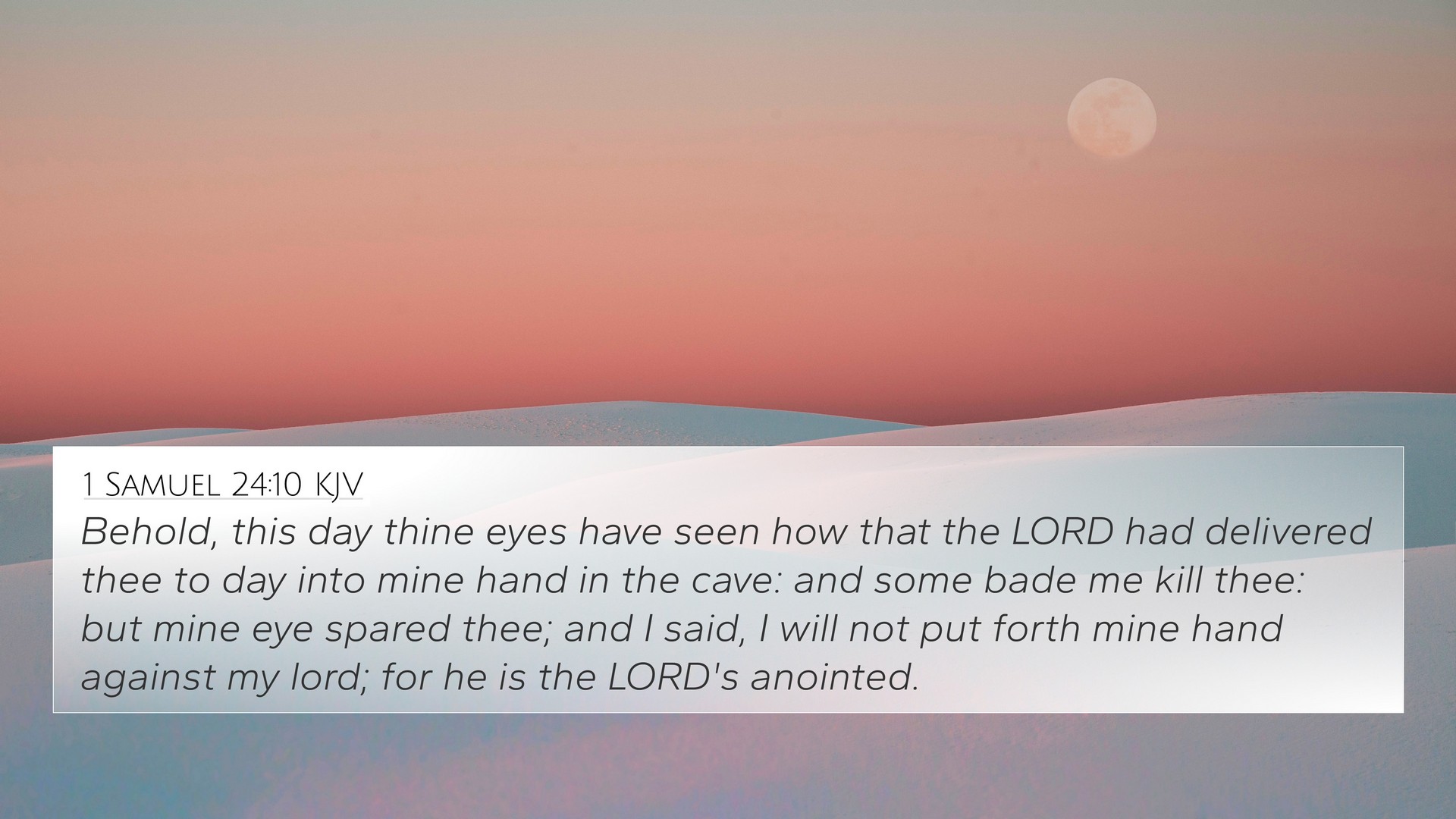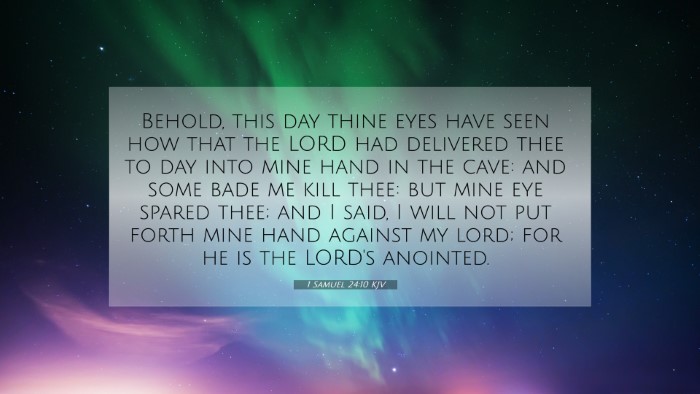Understanding 1 Samuel 24:10
Verse: "Behold, this day thy eyes have seen how that the LORD had delivered thee today into my hand in the cave: and some bade me kill thee: but mine eye spared thee; and I said, I will not put forth mine hand against my lord; for he is the LORD's anointed." (1 Samuel 24:10, KJV)
Summary of Meaning
This verse occurs in a significant moment when David has the opportunity to kill King Saul, who is pursuing him to end his life. Instead of taking vengeance, David chooses to show mercy. This act of compassion is rooted in his understanding of Saul's anointed status before God. The verse highlights themes of divine authority, mercy, and the moral struggle surrounding power and righteousness.
Commentary Insights
-
Matthew Henry:
Henry emphasizes that David's restraint reflects his respect for God's ordaining of Saul as king. Even in the midst of being wronged, David acknowledges Saul's position and chooses to let God avenge him instead of taking matters into his own hands. This act is an example of righteous behavior among those who are wronged.
-
Albert Barnes:
Barnes highlights the significance of David's words and actions as an exemplary portrayal of how believers ought to approach conflicts. By sparing Saul, David demonstrates that true leadership is characterized by mercy and self-control. This passage reveals deep lessons about trust in divine justice over personal retribution.
-
Adam Clarke:
Clarke provides a detailed examination of the setting in which this scene takes place, indicating the deep psychological and emotional turmoil both David and Saul are experiencing. Clarke draws attention to the concept of God's anointed and its implications in relation to authority and dignity that should be afforded to leadership, despite personal grievances.
Thematic Connections
This verse allows for an exploration of several biblical themes, particularly:
- Divine Authority: The anointing of Saul and the recognition of God’s sovereignty in leadership.
- Mercy and Forgiveness: David's choice not to kill Saul demonstrates the power of mercy in conflict resolution.
- Trusting God in Adversity: David exemplifies the belief that God will protect and avenge, thereby encouraging believers to rely on divine intervention rather than taking revenge themselves.
Cross-References and Inter-Biblical Dialogue
This verse connects with multiple biblical passages that reinforce its themes:
- Psalm 105:15: "Touch not mine anointed, and do my prophets no harm." - This verse reinforces the concept of respecting God's chosen leaders.
- Romans 12:19: "Vengeance is mine; I will repay, saith the Lord." - This highlights the principle of letting God deal with wrongdoers.
- 1 Peter 2:17: "Honor all men. Love the brotherhood. Fear God. Honor the king." - A call to respect authority and the divine order.
- Matthew 5:39: "But I say unto you, That ye resist not evil: but whosoever shall smite thee on thy right cheek, turn to him the other also." - Emphasizes the theme of turning the other cheek as a form of mercy.
- James 4:10: "Humble yourselves in the sight of the Lord, and he shall lift you up." - A reminder of humility in the face of opposition.
- Isaiah 53:7: "He was oppressed, and he was afflicted, yet he opened not his mouth." - A prophetic reference to the suffering servant that resonates with David's response to Saul.
- Luke 6:27-28: "But I say unto you which hear, Love your enemies, do good to them which hate you." - Encourages love towards even those who oppose us, mirroring David's actions.
Conclusion
This exploration of 1 Samuel 24:10 highlights the profound messages of respect for authority, mercy over vengeance, and the importance of trusting in God's providence for justice. Such themes form a critical part of the ethical framework laid out in Scripture, providing rich material for personal reflection and discussion within the community of faith.
Further Study Tools
For those wishing to delve deeper into the connections and commentary surrounding this verse, there are numerous resources available:
- Bible concordance for identifying key terms and themes.
- Bible cross-reference guides for discovering related verses.
- Systematic theology texts exploring the nature of God's authority and mercy.
- Commentaries that offer insights into historical and cultural contexts.
- Cross-reference Bible study methods to systematically explore interconnections among scriptures.
- Tools for comparative Bible verse analysis, especially between the Old and New Testament.
- Comprehensive Bible reference resources for deeper thematic studies.





